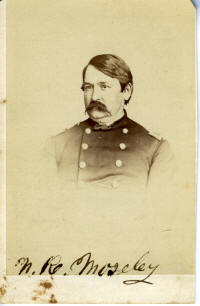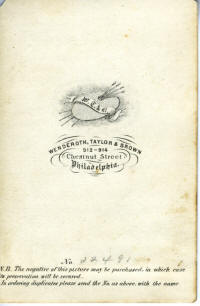N. Richards Moseley, U. S. Army
Surgeon
(aka: Mosely)
New York 36th Infantry (Washington Volunteers) Mustered out July 15, 1863
Hospital: Emery, Washington, D.C.
No. 53 West 36th St. New York City, In 1863-64-65


N. Richards Moseley was an 1847-1849 student at
the Philadelphia College of Medicine. He served as a demonstrator
of anatomy at that institution during 1849-1850 with an M.D.
degree. He later graduated from the University of Pennsylvania
1854-55 with an M.D and is listed as a graduate in 1855 in the alumni
list. (American
Swedish Historical Museum: Yearbook 1960, page 14)
Philadelphia College of Medicine
Fifth South of Walnut street
The winter course of lectures for 1850 51 will on
Monday 13th of October 1850 A preliminary will be given during the two
weeks preceding the session Degrees will be conferred early in March
1851 President Dr JR Burden Surgery Dr James M Clintock Materia Medica
Dr Rush Van Dyke Theory and Practice Dr Thomas D Mitchell Chemistry Dr
ES Carr Institutes of Medicine Dr James Bryan Anatomy Dr James M
Clintock Comparative Anatomy Dr MW Dickeson Obstetrics Dr FA Fickardt
Demonstrator of Anatomy NR Moseley MD
In 1850, Dr. N. R. Moseley was a professor of Anatomy
at what was the Female Medical College of Pennsylvania and later that
year became the the Homeopathic Medical College, then the Hanemann
Medical College.
A History of the United States Army Medical Museum
1862 to 1917 compiled from the Official Records"
In many cases the contributions
were almost entirely surgical, especially those from Army Medical
Officers during the civil war those by Allen, Armsby, Ashford,
Bliss, Bontecou, Bovee, Brinton, Bryant, Byrne, Conner, Dean, Eliot,
Gouley, Hewitt, Hodgen, Jones, Judson, Keen, Lewis, Lidell, Lincoln,
McCall, McGill, McKee, Miles,
Moseley, Moses, Munn, Norris, Notson,
Pancoast, Peters, Shrady, Smith, Stone, Summers, Thoraeon, Vanderkieft,
Uagner and Weir. In some cases the contributions were credited to the
officer in charge.
Medical/Surgical
History--Part I, Volume I
XCVIII. Extracts from a Narrative of his Services.
By Surgeon N. R. MOSELY, U. S. Volunteers.
"The men brought to this hospital were mostly wounded by the explosion
of shells. Several primary
amputations were performed under the use of a mixture of equal parts of
chloroform, and sulphuric ether. No deaths occurred. These
wounded were afterwards conveyed in ambulances to Bristoe Station, from
whence they were transported by rail to Washington."
"When admitted to the
Emery Hospital, Washington, on August 17th, 1864, he was feeble, and
much exhausted from exposure on the field, and during transportation. On
August 25th, bleeding profusely,
chloroform and ether were
administered, and the right
common carotid artery, through an incision about two inches in length,
was ligated by Surgeon N. R. Moseley, U. S.V. Cold water dressings were
applied, and tonics and stimulants were administered. He died on August
30th, 1864, from exhaustion and constitutional irritability."
Disarticulations and Amputations in the Hand: A
fragment of bone representing the base of the right ring finger
disarticulated at the metacarpus d 1 Private EC D 111th New York
admitted hospital and amputated by Surgeon NR
Mosely US Vols Washington 22d May deserted 13th July 1864
Emory General Hospital: Convalescent Hospital
Description:
Mainly a convalescent hospital, Emory General opened
in July 1862 and closed in July 1865, sending
patients to Lincoln General Hospital. Emory was
located in wooden barracks formerly used by the
Sixth U.S. Cavalry, about one mile east of the
Capitol, near the Alms house, the Congressional
Cemetery, and Lincoln General Hospital.
Surgeries reported by Surgeon Moseley:
|
Moseley, N.R. (Surgeon) |
United States Volunteers |
Reported on Sergeant H.M. Lambert's case
|
October 13, 1863 (Unknown) |
|
|
Moseley, N.R. (Surgeon) |
United States Volunteers |
Reported on Sergeant W. Walters's case
|
May
16, 1864 (Unknown) |
|
|
Moseley, N.R. (Surgeon) |
United States Volunteers |
Reported on Private W.J. Beck's case
|
June
24, 1864 (Unknown) |
|
|
Moseley, N.R. (Surgeon) |
United States Volunteers |
Operated on Private J. Glassie
|
June
3, 1864 (Unknown) |
|
|
Moseley, N.R. (Surgeon) |
United States Volunteers |
Operated on Private O. Derocher
|
May
23, 1864 (Actual) |
|
|
Moseley, N.R. (Surgeon) |
United States Volunteers |
Operated on Private G. Fuller |
August 29, 1864 (Actual) |
|
|
Moseley, N.R. (Surgeon) |
United States Volunteers |
Operated and reported on Private H. Loud
|
May
28, 1864 (Unknown) |
|
|
Moseley, N.R. (Surgeon) |
United States Volunteers |
Reported and operated on Private F. Thorn
|
May
26, 1864 (Unknown) |
|
|
Moseley, N.R. (Surgeon) |
United States Volunteers |
Operated and reported on Private H.E.
Boynton |
May
22, 1864 (Unknown) |
|
|
Moseley, N.R. (Surgeon) |
United States Volunteers |
Reported on W.S. Hodgkins's case
|
May
24, 1864 (Unknown) |
|
|
Moseley, N.R. (Surgeon) |
United States Volunteers |
Reported on Corporal A.M. Delano's case
|
May
22, 1864 (Unknown) |
|
|
Moseley, N.R. (Surgeon) |
United States Volunteers |
Reported on Private B.F. Brown's case
|
May
13, 1864 (Unknown) |
|
|
Mosely, N. R. (Surgeon) |
United States Volunteers |
Contributed the history and specimen from
the case of Sergeant Charles A. C.
|
November 1, 1860 (War Boundary) |
|
62nd Regiment
New York Volunteer Infantry
Civil War Newspaper Clippings
New York Times
2 July 1861
THE ANDERSON ZOUAVES.
The whole of this regiment has now been mustered
into the United States service; it is expected that
it will be ordered to the seat of war immediately.
The gentlemen who have brought this regiment to its
present standard of excellence, deserve great credit
for the patience and determination which they have
manifested throughout the most trying difficulties.
With scarcely any pecuniary assistance they have
sustained a large body of men during a period of
nearly two months, the greater part of the expense
falling upon Col. J. L. Riker and Lieut.-Col. H. S.
Tisdale. Other regiments have been aided to the
extent of thirty, forty and even sixty thousand
dollars by the United Defence Committee.
Notwithstanding this, the Anderson Zouaves will
compare favorably with any other regiment, as is
shown by the following certificate of the United
States Medical Inspector:
New-York, June 30, 1861.
Col. J. Lafayette Riker:
Dear
Sir: In the examination of the fine body of troops
under your command, known as the Anderson Zouaves, I
found a far less proportion of them to be physically
disqualified than I have found in any of the
regiments I have examined during the present war,
and I cheerfully testify to their general superior
condition. The scarcity of boys and old men was also
quite a remarkable feature.
N.R. MOSELEY, M. D.,
Medical Inspector.
Multiple citations in the M & S H, with a few
examples:
CASE 1165. Private G. Cornick, Co. F, 7th Wisconsin, aged 23 years, was
treated in a Fifth Corps hospital for a wound received at Spottsylvania,
May 11, 1864. He was sent to Washington on the 15th and admitted into
Emory Hospital, where Surgeon N. R. Moseley, U. S.
V., reported: "Gunshot wound of the scrotum, with laceration and
protrusion of the right testicle. The parts became gangrenous, and there
was severe constitutional disturbance from the infiltration of pus in
the right iliac region. The wound was ragged and the turgid testis was
assuming a gangrenous appearance, and there was great tender ness of the
abdomen. Chloroform and ether were administered to the patient on the
19th and the right testis removed, the operation being followed by
cold-water applications to the wound. Peritonitis set in on the same
day; it was treated with calomel, opium, brandy, and turpentine stupes
to the abdomen;" but unavailingly, as the case terminated fatally on May
23, 1864. Excision of both Testes. This operation is still frequently
performed, 1 according to Curling, by oriental barbarians; but is rarely
resorted to, even in Italy, among civilized communities, except on
account of hopeless disorganization of the testes by injury or disease.
When the testes are badly lacerated by shot, some military surgeons -
are of opinion that primary ablation 3 is preferable to an expectant
treatment because of the greater rapidity of recovery after operation.
Three cases were returned in which both testes 4 appear to have been
removed for shot injury, although the reports are somewhat vague.
CASE 1603.
Private John B , Co. C, 7th New York Heavy
Artillery, aged 27 years, was wounded at Cold
Harbor, June 3, 1864, and treated in a Second
Corps field hospital. He was thence transferred
to Washington, and admitted to Emory Hospital on
June 8th.
Surgeon N. R.
Moseley, U. S. V.,
noted : "Gunshot wound of the right arm, the
ball entering at the insertion of the deltoid,
passing upward, and lodging in the shoulder
joint. On June 16th, amputation at the shoulder
was performed by antero-posterior flaps. At this
time the wound was ecchymo*ed and oedematous,
and the bones comminuted ; constitutional
condition unfavorable, with nervous prostration.
The treatment consisted of stimulants
internally, and local pressure on the femoral
arteries to retain blood in the trunk. The
patient continued to sink, and died of collapse
six hours after the operation. The specimen (FiG.
493) consist* of the upper fourth of the right
humerus, disarticulated for fracture of the head
by a conoidal ball, which destroyed the greater
tuberosity and lodged. Several partial fractures
extend through the head and neck." Contributed
by the operator, Surgeon N. R. Moseley, U. S. V.
Also, see articles concerning Moseley:
Stomach pumps with citation for Surgeon Moseley
Use of Sulphuric Ether and Chloroform during Civil
War, 1861
|

